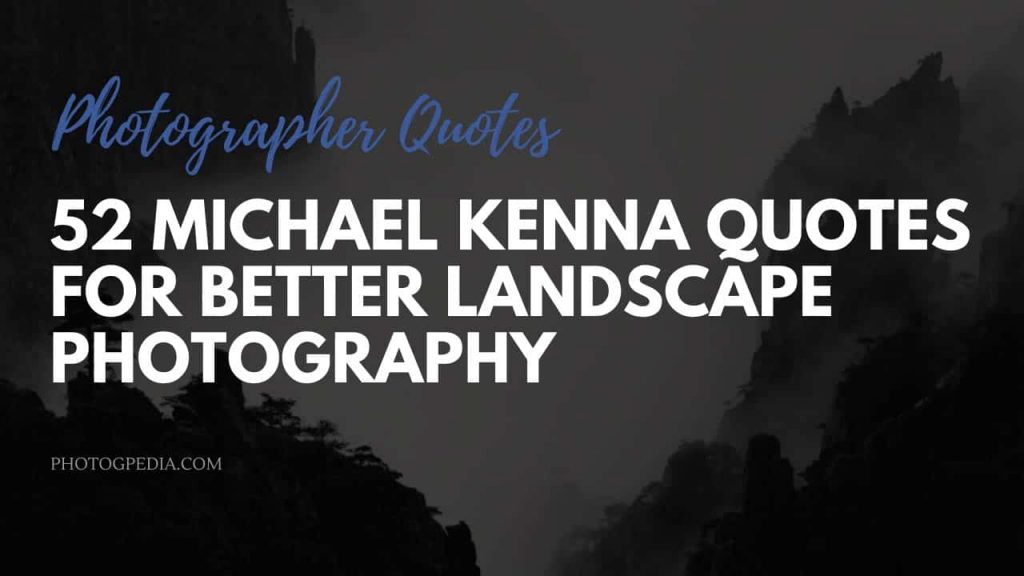Looking for the best Michael Kenna quotes? You’ve come to the right place. Below we’ve put together a list of 52 of his best quotes to inspire you and help take your landscape photography to the next level.
If you haven’t done so already, we recommend reading our Michael Kenna master profile article to learn more about his photography style, techniques, cameras, use of film and much more.
Michael Kenna Quotes
Getting photographs is not the most important thing. For me, it’s the act of photographing. It’s enlightening, therapeutic, and satisfying because the very process forces me to connect with the world. When you make four-hour exposures in the middle of the night, you inevitably slow down and begin to observe and appreciate more what’s going on around you. In our fast-paced, modern world, it’s a luxury to be able to watch the stars move across the sky.
Perhaps most intriguing of all is that it is possible to photograph what is impossible for the human eye to see – cumulative time.
In photography, it’s not difficult to reach a technical level where you don’t need to think about the technique any more. I think there is far too much literature and far too much emphasis upon the techniques of photography. The make of camera and type of film we happen to use has little bearing on the results.
There is no one way of photographing anything. I don’t believe there is even one best way of photographing any given subject.
The golden rule in the arts, as far as I am concerned, is that all rules are meant to be broken.
I would strongly encourage anybody embarking on photography as a career to embrace and enjoy the whole process. Being a photographer can be a wonderful way to experience the world.
Easier is not necessarily better.
I am not interested in describing and copying what I see. I am interested in a collaboration with the subject matter.
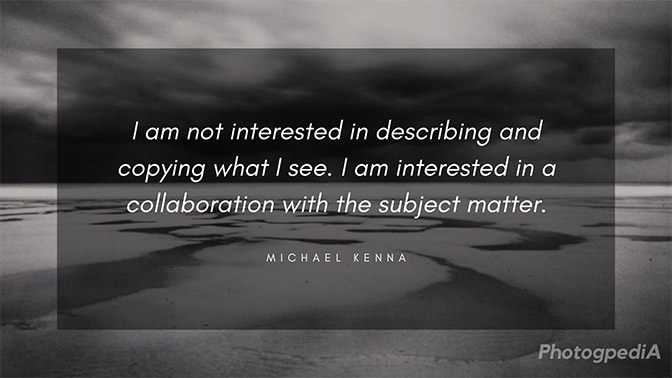
Landscape Photography Quotes
As a landscape photographer we should be open to possibilities, for one thing often leads to another.
I often think of my work as visual haiku. It is an attempt to evoke and suggest through as few elements as possible rather than to describe with tremendous detail.
I don’t think it is even possible to define what a good photograph is, so it is difficult to instruct anybody how to make one. Beauty and aesthetics are subjective, and very much in the mind of the beholder.
I encourage playfulness and experimentation with both the camera and subject matter. Sometimes there is an obvious perspective, but it is important never to be satisfied with that.
I try not to make conscious decisions about what I am looking for. I don’t make elaborate preparations before I go to a location. Essentially I walk, explore, discover and photograph.
Michael Kenna Quotes on Finding Locations
I often use the analogy of a theatre stage. I prefer to photograph the stage before the characters appear, and after they leave.
Essentially, I look for what is interesting to me, out there in the three-dimensional world, and translate or interpret so that it becomes visually pleasing in a two-dimensional photographic print. I search for subject matter with visual patterns, interesting abstractions, and graphic compositions.
I enjoy places that have mystery and atmosphere, perhaps a patina of age, a suggestion rather than a description, a question or two. I look for memories, traces, evidence of the human interaction with the landscape. Sometimes I photograph pure nature, sometimes urban structures.
Parks and gardens are the quintessential intimate landscapes. People use them all the time, leaving their energy and memories behind. It’s what’s left behind that I like to photograph.
In my photographic work, I’m generally attracted to places that contain memories, history, atmospheres, and stories. I’m interested in the places where people have lived, worked, and played. I look for traces of the past, visual fingerprints, evidence of activities – they fire my imagination and connect into my own personal experiences.
I gravitate towards places where humans have been and are no more, to the edge of man’s influence, where the elements are taking over or convering man’s traces.
Different assignments, different places, require different approaches. Sometimes I take minutes in a location, at other times days. There are many places that I have returned to over several years. When I photograph, I look for some sort of resonance, connection, spark of recognition.

Patience and Time
Approaching subject matter to photograph is like meeting a person and beginning a conversation. How does one know ahead of time where that will lead, what the subject matter will be, how intimate it will become, how long the potential relationship will last? Certainly, a sense of curiosity and a willingness to be patient to allow the subject matter to reveal itself are important elements in this process.
Most people are content just to take instant photographs and put them out into the world very quickly and easily. There are always going to be some who take the time and delve deeper. It’s a bit like using Garageband on the computer. You can make music very quickly, but to really master an instrument takes years.
Instant gratification in photography is not something that I need or desire. I find that the long, slow journey to the final print captivates me far more.
Most of my work involves slowing down rather than speeding up. I prefer to look at prints than scans, and I prefer to look at original silver prints rather than digital prints. I prefer to look at fewer images, but spend time with those individual images.
Returning to the Same Location
The first time, I usually skim off the outer layer and end up with photographs that are fairly obvious. The second time, I have to look a little deeper. The images get more interesting. The third time it is even more challenging and on each subsequent occasion, the images should get stronger, but it takes more effort to get them.
I prefer to think of photography as a never ending journey with infinite possibilities. I love to return to places to re photograph. Nothing is ever the same. The options are endless.
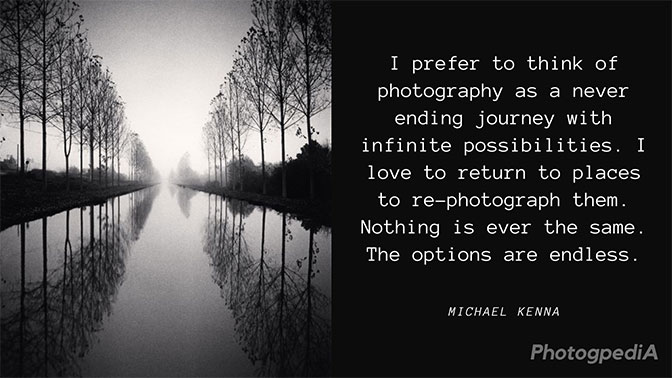
Accidents and Chance
Life is about turning up. The more you get yourself out there, whether you wake up at 5:00 a.m. to pouring rain or not, the more you’re likely to experience the wonderful happenings that are going on all around you. Sometimes the most interesting visual phenomena occur when you least expect it. Other times, you think you’re getting something amazing and the photographs turn out to be boring and predictable. So I think that’s why, a long time ago, I consciously tried to let go of artist’s angst, and instead just hope for the best and enjoy it. I love the journey as much as the destination. If I wasn’t a photographer, I’d still be a traveler.
There can be no doubt that probability increases with practice. Fortune favours the brave, fortune favours the prepared mind, and fortune favours those who work the hardest.
One needs to fully accept that surprises sometimes happen and complete control over the outcome is not necessary or even desirable.
Many of my stronger photographs are the result of my option not to pre-visualize. I believe that it’s important to allow the possibility of an accident and not be too controlling.
We have infinite options of how to photograph something. That extends into the darkroom afterwards. That’s one of the reasons I haven’t gone over to digital. I prefer the slowness, the unpredictability, the complications. You never know what you have. It’s like the excitement of opening up a Christmas package when you get your negatives back.
For me, this is one of the advantages of not using digital, I never know when I have a good photograph! I practice doubt as a way to push myself into alternative compositions by selective focus, different speeds of exposure, and unusual perspectives.
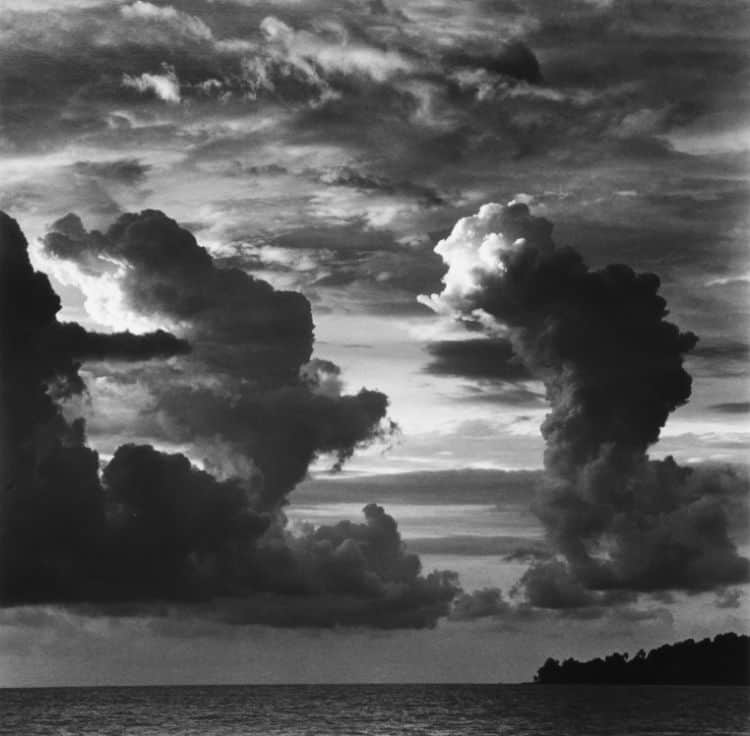
Night Photography
There are many characteristics associated with night photography that make it fascinating. We are used to working with a single light source, the sun, so multiple lights that come from an assortment of directions can be quite surreal, and theatrical. Drama is usually increased with the resulting deep shadows from artificial lights. These shadows can invite us to imagine what is hidden. I particularly like what happens with long exposures, for example, moving clouds produce unique areas of interesting density in the sky, stars and planes produce white lines, rough water transforms into ice or mist, etc. Film can accumulate light and record events that our eyes are incapable of seeing. The aspect of unpredictability inherent with night exposures can also be a good antidote for previsualization…
Camera Equipment and Film
I have a backpack and that determines how many cameras I carry. I insist that I can carry what I use to photograph as I don’t usually have an assistant. The backpack can hold two 120 camera bodies, two film backs, and two viewfinders. One is metered through the lens and the other one is a waist level.
It’s possible to think of photography as an act of editing, a matter of where you put your rectangle pull it out or take it away. Sometimes people ask me about films, cameras and development times in order to find out how to do landscape photography. The first thing I do in landscape photography is go out there and talk to the land – form a relationship, ask permission, it’s not about going out there like some paparazzi with a Leica and snapping a few pictures, before running off to print them.
Craft is important, but cameras for their own sake are not. A sense of aesthetics, a connection with the subject matter, an enquiring, and an inquisitive mind, these factors outweigh whatever equipment we use.
If I had to give advice to other photographers, I would first suggest quickly getting over the camera equipment questions. In my humble opinion, the make and format of a camera is ultimately low on the priority scale when it comes to making pictures.
Of course, the whole photographic process has been made much faster, cleaner and far more accessible to people by digital innovations, which is really great. Everybody now has a camera, often as part of our phone, and most of these cameras require little to no technical training. An enormous variety of apps also enable us to take short cuts to finished images. We hardly need to even think anymore.
Everybody now has a camera, whether it is a professional instrument or just part of a phone. Landscape photography is a pastime enjoyed by more and more. Getting it right is not an issue. It is difficult to make a mistake with the sophisticated technology we now have. Making a personal and creative image is a far greater challenge.
I believe that every photographer, every artist, should choose materials and equipment based on their own vision. I don’t believe that non-digital is necessarily better than digital, or the reverse for that matter. They are just different, and it is my preference and choice to remain with the traditional silver process, at least for the time being.
Black and White Photography
We see in colour all the time. Everything around us is in colour. Black and white is therefore immediately an interpretation of the world, rather than a copy.
I use black and white film. For the most part, I use Kodak Tri-X. 400asa film. One of the nice things about this film is that it hasn’t changed much since I first started 40 years ago. It’s like an old friend; It’s flexible and forgiving, and easy to work with. That’s why I still use it. I also use other films depending on which country I am in and where I can buy the films. Tri-X is my old stand by.
I don’t have anything against colour. It is just not my first preference. I have always found black and white photographs to be quieter and more mysterious than those made in colour.
I find black and white to be more malleable and mysterious than color; it is more an interpretation of reality than a reflection of reality.
For me, the subtlety of black and white inspires the imagination of the individual viewer to complete the picture in the mind’s eye. It doesn’t attempt to compete with the outside world. I believe it is calmer and gentler than colour, and persists longer in our visual memory.
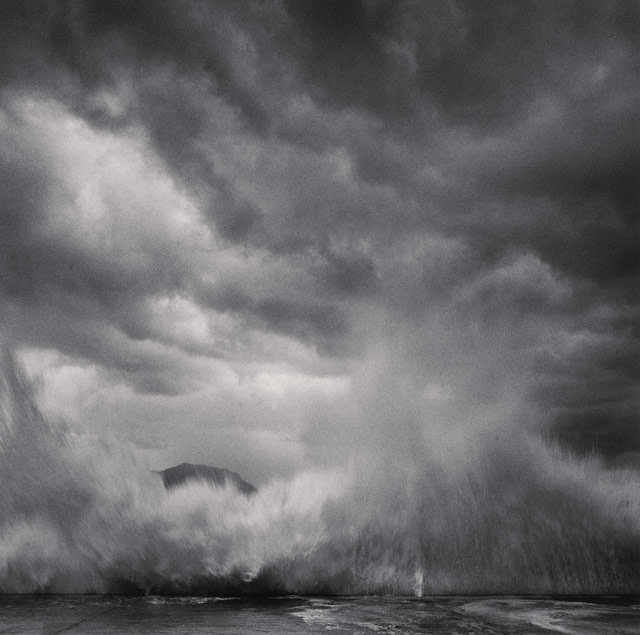
Michael Kenna Darkroom and Print Quotes
I believe printmaking is a critical component of the photographic process and I will always try to do it myself. The negative is raw material, which a skilled and creative printmaker can mold in a thousand different ways. There are many technical and aesthetic decisions to be made along the way, the sum of which makes a print unique and very personal.
Small prints have a greater feeling of intimacy – one looks into the print. Large prints are more awesome – they are something a viewer looks out at. I believe in fitting the print size to one’s particular vision and prefer the more intimate engagement of the smaller image.
Influences and Style Quotes
I sincerely believe it is normal and healthy to study the work of other artists, and even imitate other’s efforts, as a means to explore one’s personal vision. It has been thus throughout history in all mediums of creative expression. One advances by “standing on the shoulders of giants”. The perspective becomes a lot clearer from such high ground.
On my own journey, I have actively tried to see through the eyes of many well known photographers, including but not limited to Atget, Bernhard, Brandt, Callahan, Cartier Bresson, Giacomelli, Misrach, Scheeler, Steiglitz, Sudek, Sugimoto, Weston (Brett) and many others. I have gone to places where they have photographed and have consciously and unconsciously emulated their style and subject matter.
Other artists, in many mediums, have greatly helped my own development as a photographer. As small tokens of appreciation, I have often credited those influences openly by including their names in the titles of work. I have done this out of basic courtesy and respect. I do not feel that I have ever stolen from these artists.
My advice to any budding artist is never to be satisfied with imitating others. This is but a means to an end. A serious artist will work with intensity to discover themselves, their own personal vision. I believe this is a fundamental aspect of the creative path.
There are many aspects about what and why we photograph: visual pleasure, personal empathy, intellectual stimulation, technical excellence, etc. Serious photographers and artists will try to create works that are original. Over a career period they may develop a singular identity in their images.
The photographer Ruth Bernhard used to tell me that this is like asking somebody how they evolved their signature. It is not something I’ve ever worked on consciously. I think style is just the end result of personal experience. It would be problematic for me to photograph in another style. I’m drawn to places and subject matter that have personal connections for me and I photograph in a way that seems right. Where does it all come from, who knows?
I believe that we photographers don’t benefit very much with answers from other photographers. What is more beneficial is to ask questions of ourselves and see what thoughts float out from within.
I believe that photographers should be passionate, determined, disciplined and ready to seek out their own styles and identities.
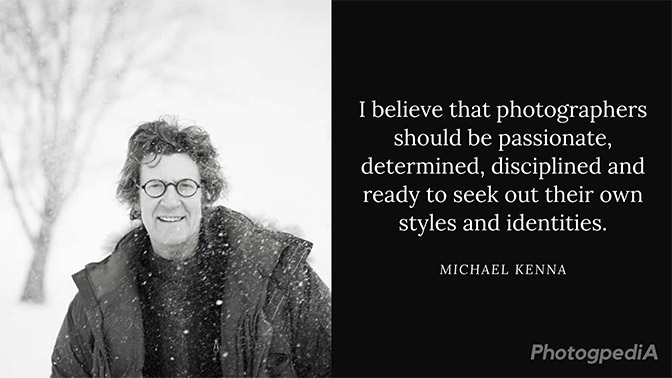
What’s your Favorite Michael Kenna Quote?
Have a favorite Michael Kenna quote from the list? Let us know in the comment section below.
If you would like to learn more about Michael Kenna’s photography, we recommend reading our Michael Kenna profile article. To see more Kenna’s remarkable landscape work, check out the image archive on his official website.
Don’t forget to bookmark this page, or print it out, and refer to it next time you need some inspiration. Also, don’t forget to share it with others through the usual channels (social media, forums, websites, etc).
Looking for more words of wisdom from master photographers? Visit the quotes section of Photogpedia for more great photography quotes.
More Quote Articles:

